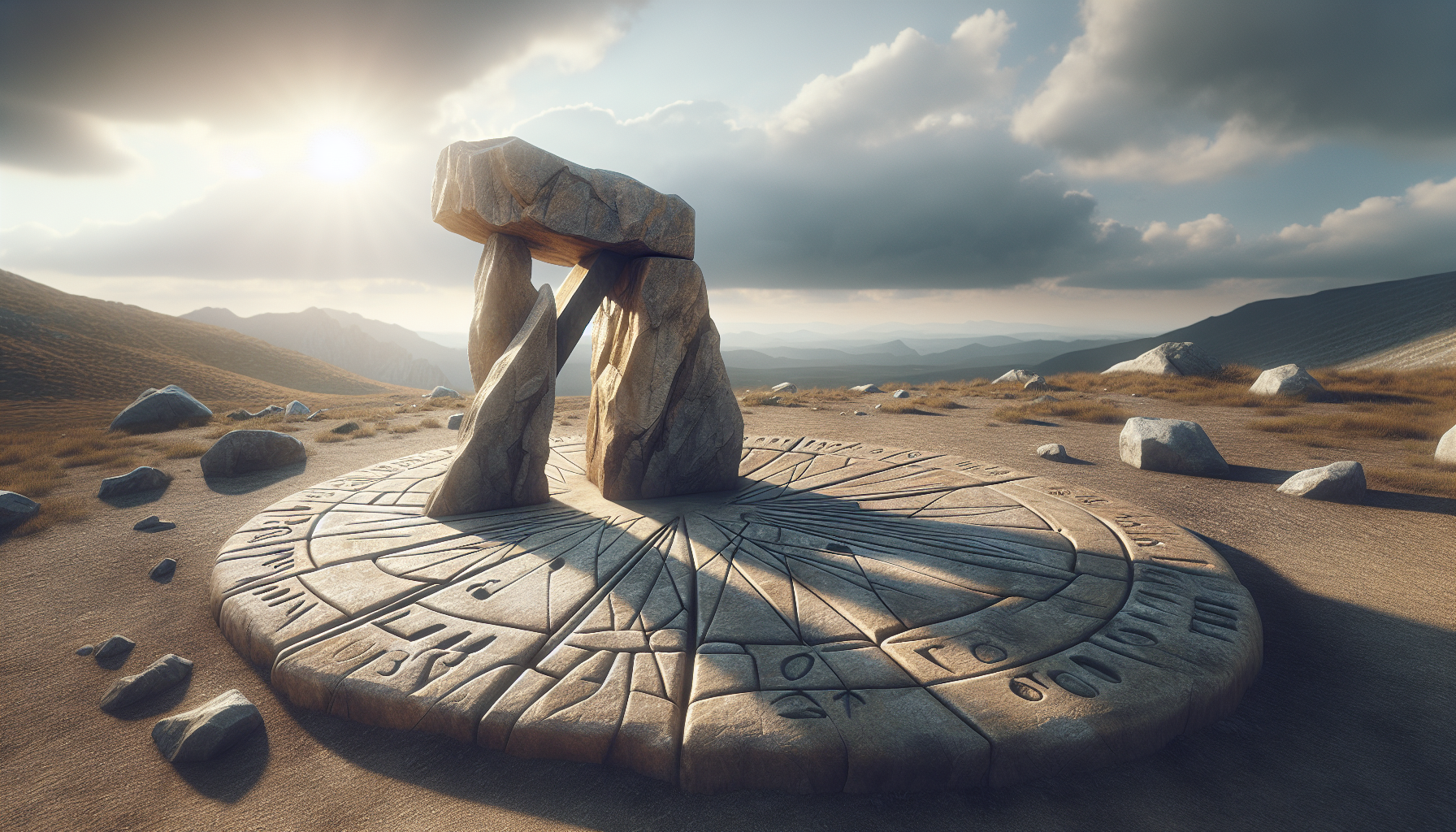In an age where our lives are governed by the ticking of clocks and the relentless march of digital seconds, it is easy to forget that humanity’s quest to measure time stretches back millennia. Long before the advent of atomic clocks or even the mechanical wonders of the Middle Ages, ancient civilizations looked to the heavens and the earth to mark the passage of time. One of the most fascinating and enduring methods they developed was the sundial, a testament to human ingenuity and our innate desire to understand the cosmos. Among these timekeeping marvels, megalithic sundials stand out as both monumental and precise, harnessing the power of massive stones to capture the sun’s dance across the sky. 🌞
In this exploration of ancient sundials, we delve into the intriguing intersection of art, science, and spirituality that these structures embody. From the towering stones of Stonehenge, with their enigmatic alignments, to the intricate carvings found in the sundials of ancient Egypt and the Indian subcontinent, these megaliths offer a glimpse into the sophisticated understanding of astronomy possessed by our ancestors. They serve not only as tools for measuring time but also as cultural artifacts that reflect the values, beliefs, and technological prowess of the societies that built them. As we journey through history, we’ll uncover how these ancient architects achieved such precision, and what these timekeeping monuments tell us about the people who crafted them.
Prepare to be captivated by the stories of ingenuity and mystery that surround these ancient structures. We’ll explore the technical aspects of how these sundials worked, the materials and methods used in their construction, and the cultural and religious significance they held. Along the way, we’ll meet the astronomers and builders whose legacy endures in stone, and consider what lessons these ancient timekeepers have for us today in an era where time is both a resource and a commodity. Whether you are a history enthusiast, a lover of ancient mysteries, or simply curious about how our ancestors made sense of the natural world, this journey through the world of ancient megalithic sundials promises to enlighten and inspire. 🕰️
The Historical Significance of Sundials
Ancient sundials represent one of the earliest forms of timekeeping, tracing back to civilizations such as the Egyptians and the Babylonians. These early devices were instrumental in the development of human understanding of time and its passage, marking a significant leap in scientific thought. Sundials harness the position of the sun in the sky to cast a shadow on a marked surface, providing an indication of the time. Their historical relevance is profound, as they were used to guide daily activities, religious rituals, and even agricultural practices.
The Egyptians were among the pioneers in sundial usage, developing a simple tool known as the shadow clock. This consisted of a vertical stick or pillar, known as a gnomon, which cast a shadow on a flat surface. As the sun moved across the sky, the length and position of the shadow changed, allowing people to estimate the time of day. The sophistication of Egyptian sundials increased over time, leading to more complex designs that could measure time more accurately.
Similarly, the Babylonians made significant advancements in sundial technology. They developed the hemispherical sundial, which used a hollow half-sphere with a pointer at the center. The shadow of the pointer would move along the curved surface, indicating the time. This invention was a remarkable feat of engineering and demonstrated a deep understanding of geometry and astronomy. The impact of these early sundials extended beyond mere timekeeping; they contributed to the development of mathematics and astronomy, providing a foundation for future scientific discoveries.
The Role of Sundials in Ancient Cultures
Sundials played a crucial role in the daily lives of ancient cultures. They were not only practical tools for timekeeping but also held cultural and religious significance. In many societies, sundials were placed in prominent locations, such as temple grounds or city centers, symbolizing the connection between the celestial and the terrestrial. Their presence in these public spaces reflected the importance of time management in organizing communal activities and religious ceremonies.
In ancient Greece, sundials were widely used and further refined by mathematicians and astronomers. The Greeks developed various types of sundials, each tailored for specific latitudes and locations. One of the most notable advancements was the analemmatic sundial, which employed an elliptical layout and allowed for greater accuracy. This innovation demonstrated the Greeks’ commitment to precision and their deep interest in understanding the cosmos.
Moreover, sundials were intricately linked with the concept of the divine. In many ancient cultures, the sun was regarded as a deity, and sundials were seen as tools that harnessed the power of the divine to serve humanity. This belief imbued sundials with a sacred status, elevating their importance beyond mere practicality. Understanding the cultural context of sundials provides insight into how ancient civilizations perceived time and their place within the universe.
Megalithic Structures and Sundials
Megalithic structures, often associated with ancient rituals and astronomical observations, also played a significant role in timekeeping. These massive stone formations, such as Stonehenge in England and the Carnac stones in France, have long fascinated historians and archaeologists due to their mysterious origins and purposes. Recent studies suggest that these structures may have functioned as complex sundials, aligning with the movement of the sun to mark significant astronomical events, such as solstices and equinoxes.
The alignment of megalithic structures with celestial bodies indicates a sophisticated understanding of astronomy by ancient peoples. For instance, Stonehenge is famously aligned with the summer solstice sunrise, suggesting that it may have been used to track the solar calendar. The precision with which these stones were positioned reflects a deep knowledge of the solar cycle, allowing ancient civilizations to anticipate seasonal changes and plan agricultural activities accordingly.
Furthermore, the scale and complexity of megalithic structures imply a significant investment of resources and labor, underscoring their importance in ancient societies. These structures may have served multiple purposes, functioning as both ceremonial sites and practical tools for timekeeping. The integration of megaliths with sundial technology highlights the ingenuity of our ancestors in utilizing natural elements to enhance their understanding of time.
The Engineering Behind Megalithic Sundials
Constructing a megalithic sundial required a deep understanding of geometry, astronomy, and engineering. The builders needed to accurately align the stones with the cardinal points and celestial events, a task that necessitated precise calculations and observations. This level of sophistication suggests that ancient civilizations possessed advanced knowledge and skills, challenging the notion that these societies were primitive or unsophisticated.
In addition to their astronomical alignments, megalithic sundials often featured intricate carvings and engravings. These designs may have served both decorative and functional purposes, aiding in the interpretation of the shadows cast by the stones. The integration of art and science in megalithic sundials reflects the holistic approach to knowledge characteristic of ancient societies, where disciplines such as mathematics, astronomy, and art were interconnected.
To better understand the engineering behind megalithic sundials, researchers have employed modern technology, such as 3D modeling and computer simulations. These tools allow for a detailed analysis of the structures’ alignments and their potential uses as timekeeping devices. Such studies provide valuable insights into the capabilities of ancient engineers and the innovative ways in which they harnessed natural resources for scientific purposes.
Comparative Analysis: Sundials Across Different Cultures
The diversity of sundial designs across different cultures highlights the adaptability and creativity of ancient peoples in timekeeping. Each civilization developed unique variations of sundials, tailored to their specific geographical and cultural contexts. The following table provides a comparative analysis of sundials from three ancient cultures: Egyptian, Greek, and Chinese.
| Culture | Sundial Type | Features |
|---|---|---|
| Egyptian | Shadow Clock | Simple design, vertical gnomon, used for daily timekeeping |
| Greek | Analemmatic Sundial | Elliptical layout, precise time measurement, varied designs for different latitudes |
| Chinese | Horizontal Sundial | Flat surface, calibrated to local latitude, often incorporated with water clocks |
Each type of sundial reflects the unique needs and innovations of its respective culture. The Egyptian shadow clock, with its straightforward design, was well-suited to the sunny climate of Egypt, providing a reliable means of timekeeping for daily activities. In contrast, the Greek analemmatic sundial demonstrated a more sophisticated approach, accommodating variations in latitude to achieve greater accuracy. This reflects the Greeks’ interest in precision and their advanced understanding of mathematics.
Meanwhile, the Chinese horizontal sundial exemplifies the integration of different timekeeping technologies. Often used in conjunction with water clocks, these sundials provided a comprehensive system for measuring time, demonstrating the Chinese emphasis on accuracy and reliability. The diversity of sundial designs highlights the ingenuity of ancient cultures in adapting to their environments and the universal human desire to understand and measure the passage of time.
The Influence of Geography on Sundial Design
Geography played a crucial role in shaping the design and functionality of sundials across different cultures. The latitude and climate of a region determined the most effective type of sundial for that area. For example, regions closer to the equator, with their relatively consistent day lengths, could rely on simpler designs, such as vertical gnomons. In contrast, areas with greater seasonal variation required more complex designs, such as analemmatic sundials, to account for changes in the sun’s path.
The materials available in a region also influenced sundial design. Cultures with access to abundant stone resources, such as the Egyptians, could construct durable and long-lasting sundials. In contrast, regions with limited stone resources might have used wood or other materials, leading to different design considerations. The availability of materials and the environmental conditions of a region were significant factors in the evolution of sundial technology, shaping the innovations and adaptations seen across different cultures.
Understanding the influence of geography on sundial design provides valuable insight into the challenges and solutions encountered by ancient peoples in their pursuit of accurate timekeeping. It highlights the adaptability and creativity of human societies in overcoming environmental constraints and harnessing natural resources to achieve their goals.
Modern Applications and Legacy of Ancient Sundials
The legacy of ancient sundials is evident in modern timekeeping and astronomical practices. Although sundials have largely been replaced by more advanced technologies, such as clocks and digital devices, they continue to inspire and inform contemporary scientific endeavors. The principles of sundial construction, rooted in geometry and astronomy, remain relevant in the design of modern instruments and the study of celestial phenomena.
In educational settings, sundials serve as valuable tools for teaching concepts related to time, astronomy, and mathematics. They provide a tangible connection to the past, allowing students to explore the scientific achievements of ancient cultures and their impact on modern knowledge. The simplicity and elegance of sundials make them accessible and engaging, fostering a deeper understanding of scientific principles.
Moreover, sundials have found a place in art and architecture, with many modern designs incorporating elements of ancient sundial technology. Public installations, such as parks and gardens, often feature sundials as decorative and educational elements, bridging the gap between past and present. These installations serve as reminders of the enduring legacy of ancient sundials and their continued relevance in our understanding of time and the cosmos.
The Integration of Technology and Tradition
Modern technology has enabled the integration of traditional sundial concepts with contemporary innovations. For example, solar-powered sundials use photovoltaic cells to power digital displays, combining the ancient principle of using the sun to measure time with modern digital technology. This fusion of old and new demonstrates the adaptability of sundial principles and their potential for continued evolution.
Furthermore, the use of computer modeling and simulations has enhanced our understanding of ancient sundials and their construction. Researchers can now recreate ancient designs and test their accuracy using digital tools, providing insights into the capabilities of ancient engineers and the sophistication of their timekeeping methods. These advancements underscore the relevance of sundial principles in modern scientific research and their potential to inform future developments.
To explore the fascinating world of sundials further, watch this insightful video on ancient sundials and their modern applications: Ancient Sundials: Timekeeping Through the Ages – Science Channel. Discover how the legacy of ancient timekeeping continues to influence contemporary science and technology.
- Explore the rich history of sundials and their impact on ancient cultures.
- Understand the engineering and astronomical principles behind megalithic structures.
- Learn about the diverse designs of sundials across different cultures and their geographical influences.
- Discover the modern applications of ancient sundial technology and its ongoing legacy.

Conclusion
In conclusion, the exploration of ancient sundials and their association with megalithic structures reveals a fascinating intersection of astronomy, architecture, and human ingenuity. Throughout the article, we have delved into the historical context of sundials, tracing their evolution from rudimentary shadow clocks to sophisticated instruments of timekeeping. We have examined the architectural marvels of megaliths, uncovering their role not just as cultural and spiritual landmarks, but as precise tools for tracking celestial movements. This study underscores how ancient civilizations, through keen observation and innovative thinking, harnessed natural phenomena to forge systems that have laid the foundation for modern timekeeping.
A key takeaway from our discussion is the remarkable precision achieved by these early societies. Despite the absence of advanced technology, they were able to construct sundials that aligned with astronomical events such as solstices and equinoxes. These alignments were not coincidental but the result of meticulous planning and a deep understanding of the solar cycle. The integration of sundials with megalithic structures is a testament to the advanced knowledge and skills of ancient builders, who combined art, science, and spirituality in their designs.
The importance of this subject lies not only in its historical significance but also in its relevance to modern science and engineering. By studying ancient sundials and megaliths, contemporary researchers can gain insights into early methods of astronomical measurement and architectural design. These insights can inform current practices, inspiring innovation in sustainable architecture and the development of eco-friendly timekeeping systems. Furthermore, this topic encourages a broader appreciation for the cultural heritage and scientific achievements of our ancestors, fostering a sense of continuity and shared human experience.
I urge you, dear reader, to reflect on the ingenuity and creativity of ancient civilizations. Consider how their legacy can be applied in today’s world, whether through academic research, educational initiatives, or practical applications in design and technology. Your engagement with this topic can contribute to preserving and disseminating knowledge about these remarkable achievements.
Feel free to share your thoughts and discoveries in the comments section. Engaging in discussion not only enriches your understanding but also contributes to a collective learning experience. Sharing this article with others can spark curiosity and appreciation for the history of timekeeping, encouraging further exploration and study.
Moreover, if you have access to historical sites or museums, consider visiting exhibits on ancient timekeeping devices. Experiencing these artifacts firsthand can deepen your appreciation for the craftsmanship and scientific understanding of ancient societies. As we continue to uncover the mysteries of the past, let us be inspired by the ingenuity and foresight of those who came before us.
In closing, the study of ancient sundials and megaliths offers valuable lessons in observation, innovation, and resilience. By embracing the wisdom of the ancients, we can continue to advance our understanding of the world and our place within it. As you carry this knowledge forward, may it inspire you to look to the past not just for answers, but for inspiration to shape a future that honors the legacy of human achievement. 🌞
For further exploration, you might find these resources helpful:
– Ancient History Encyclopedia on Sundials
These sources provide additional context and detailed insights into the fascinating world of ancient timekeeping. Let us continue to explore and learn, fostering a deeper connection with our shared human heritage.
Toni Santos is a visual storyteller and cosmic interpreter whose work illuminates the ancient skywatchers and their prehistoric astronomy—the profound ways early humans observed and revered the heavens before written history. Through a visionary lens, Toni explores how the stars, planets, and celestial cycles shaped myth, ritual, and survival in cultures lost to time.
Rooted in a fascination with archaic observatories, stone alignments, and celestial symbolism, Toni’s creative journey reveals the deep human impulse to understand and harmonize with the cosmos. From lunar phases guiding planting seasons to the sacred paths of the Milky Way, each of his works embodies the awe and knowledge encoded in the night sky.
Combining artistic craftsmanship with archaeological insight, Toni’s pieces evoke the mystery and precision of prehistoric astronomers. His work does more than depict—it channels the timeless dance between earth and sky, bridging ancient wisdom with contemporary wonder.
As the visionary behind Vizovex, Toni shares curated visuals, essays, and symbolic studies that invite others to reconnect with the cosmic heritage written in stone and starlight. His creations are a call to look upward, to listen to the silent stories told by the stars, and to honor the first astronomers who mapped the heavens with reverence and ingenuity.
His work is a tribute to:
The celestial wisdom of prehistoric peoples
The sacred geometry of ancient observatories
The enduring bond between human culture and the cosmos
Whether you’re a stargazer, a scholar of ancient mysteries, or someone captivated by the universe’s earliest storytellers, Toni welcomes you to journey through a space where the sky is both map and myth—one constellation, one ritual, one revelation at a time.




